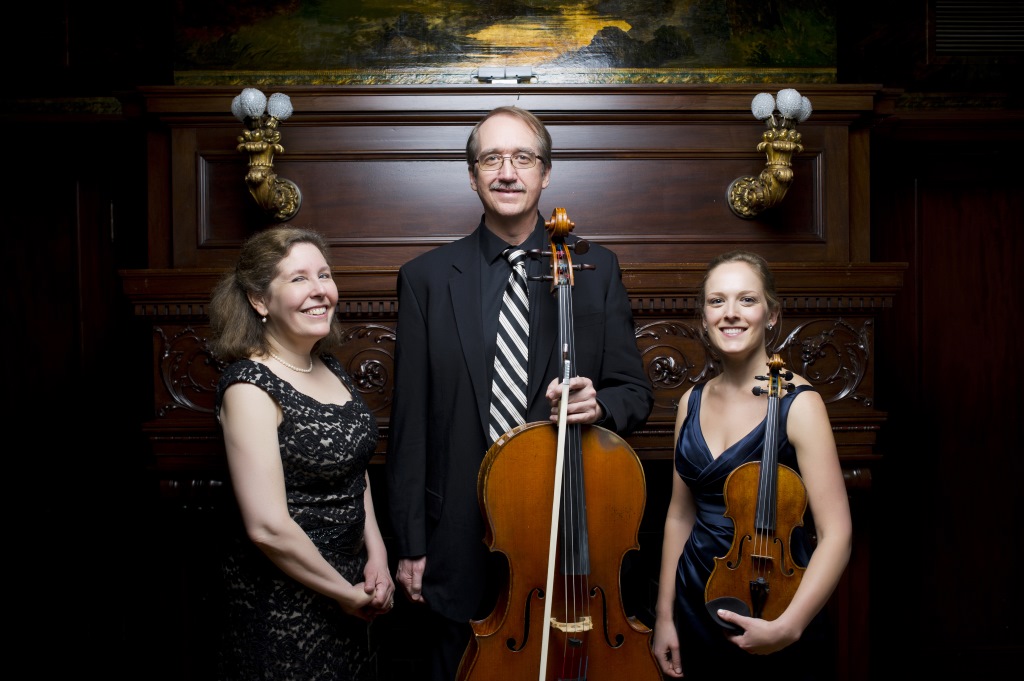Three Centuries of Great Piano Trios
Prometheus Trio plays three very different works by Haydn, Schumann and Ives.
Classical music spans many centuries, which can result in some fascinating programs mixing works of different eras. Next Monday evening and Tuesday morning, the Prometheus Trio (pianist Stefanie Jacob, violinist Margot Schwartz and cellist Scott Tisdel) will feature a three-century survey of great piano trios.
The concert opens with a late 18th century work by Franz Josef Haydn, the Trio in D Major, Hob. XV:24 (1795). Haydn was greatly influential and his music defined this and other chamber genres, giving shape to a piano trio with balanced participation by all three players. Critic Robert Philip notes the advanced character of this work: “The first movement is on quite a large scale, full of pauses and surprises, sudden offbeat accents and bursts of energy—just the effects that Beethoven was beginning to exploit. The writing for piano makes full use of the English grand pianos Haydn had got to know, with rich chords, bold octaves in the bass and much brilliant elaboration above.”
Notably, Haydn’s frequent use of humor is not evident in this more serious work, whose ending, Jacob observes, is “far from the sprightly romp that is more typical of Haydn’s closing movements” and is instead “a lyrical, graceful minuet.”
The Prometheus Trio selected Charles Ives to represent the 20th century. What is one to make of the polytonality, polyrhythm, tone clusters and other elements in the experimental music of Ives? I appreciate critic Jan Swafford‘s perspective on this:
“If you’re the keyboard-prodigy son of an imaginative small-town bandmaster father who, in the 1880s, teaches his son to sing in one key while he accompanies in another; who tells the boy he can write any chord as long as he knows the reason for it; who marches two bands around the town green playing different tunes to see what it sounds like when they pass—if you grow up with a father like that while being educated in traditional skills, and if you’ve got the guts to keep experimenting with the materials of music when everybody, but everybody, tells you you’re crazy—then you’re in the direction of a Charles Ives.”
Ives imagined his experiences on the Yale campus when he wrote his only piano trio (in 1904-5, revised 1911). The three movements are starkly different from each other. The first movement eases us into Ives compound compositional style with duos – each instrument pursuing a separate, but complementary path. Memories of a Yale party atmosphere permeate a raucous central movement. We are surrounded by layers of music. Samples of familiar music from two dozen sources emerge from the mix. “In these pieces, he discovered ways of putting into notes not only the tunes but the feelings he heard people express through everyday music in his childhood,” Swafford writes.
The concert will close with a 19th century work by Robert Schumann – his Trio in G Minor No. 3, Op. 110 (1851). With Schumann, the whole is always greater than the sum of the parts. Critic Mosco Carter notes that Schumann had a tendency with certain pieces “to build up a whole movement from a single-pattern theme, to swamp it with a melodic-rhythmic ostinato.”
But tenderness permeates a second slow movement, a deeply expressive duet for violin and cello which critic Kai Christiansen calls “an exquisite operatic duet for violin and cello with all the loving and intertwined filigree these instruments can ‘sing’ [including] drama, heroism and tragedy, the wild snares of natural passion and bold juxtapositions.”
After an agitated scherzo movement, the finale marked “Kräftig, hit Humor” (energetically, with humor) seems the ideal way to cap the concert. Jacob notes that the movement is marked by “unbounded joviality (and an) atmosphere of rejoicing.” That’s a good fit for a Prometheus Trio performance.
The Prometheus Trio will perform on two days – Monday, February 8th at 7:30 p.m. and Tuesday, February 9th at 11:00 a.m. at the Wisconsin Conservatory of Music on 1584 N. Prospect Ave. For ticket information see the WCM website or call (414) 276-5760. Additional evening parking is available at Milwaukee Eye Care, 1684 N Prospect Ave. (at Brady St). That parking option is not available for the Tuesday morning concert, but street parking should be more available.
Preview
-
A Sacred Choir, 70 Voices Strong
 Dec 14th, 2025 by Martha Brown
Dec 14th, 2025 by Martha Brown
-
Prometheus Trio Goes Bohemian
 Dec 3rd, 2025 by Martha Brown
Dec 3rd, 2025 by Martha Brown
-
Present Music Offers New Choral Works
 Nov 20th, 2025 by Michael Barndt
Nov 20th, 2025 by Michael Barndt






















